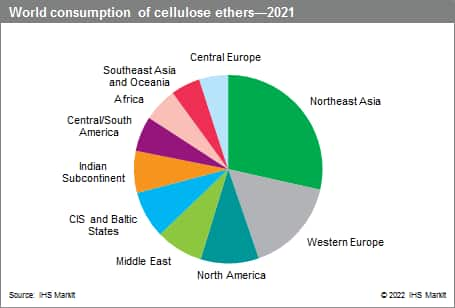Published May 2022
Cellulose ethers are water-soluble polymers produced by the chemical modification of cellulose. The major commercial cellulose ethers include carboxymethylcellulose (CMC), methylcellulose (MC) and derivatives such as hydroxypropyl methylcellulose (HPMC) and hydroxyethyl methylcellulose (HEMC), hydroxyethylcellulose (HEC) and derivatives such as ethyl hydroxyethylcellulose (EHEC) and methyl ethyl hydroxyethylcellulose (MEHEC), hydroxypropyl cellulose (HPC), and ethylcellulose (EC).
Cellulose ethers function as stabilizers, thickeners, and viscosity modifiers in many industries, including food, pharmaceuticals, personal care products, oil field chemicals, construction, paper, adhesives, and textiles. In select applications, they compete with each other and with synthetic water-soluble polymers (polyvinyl alcohol, polyurethane associative thickeners, polyacrylates) and natural water-soluble polymers (xanthan gum, carrageenan, locust bean gum). The choice of polymer is determined by price/performance trade-offs, availability, and ease of product reformulation based on price/performance considerations.
The following pie chart shows world consumption of cellulose ethers:

CMC is the major cellulose ether consumed worldwide, accounting for almost half of the total consumption volume in 2021. The largest end uses are detergents, food, and construction/building materials. Other end uses in personal care/pharmaceuticals and oil field applications. Demand for CMC in the oil field sector is volatile and depends on the price of crude oil. In addition, CMC faces competition from other water-soluble polymers such as xanthan gum that have performance advantages in certain end uses (e.g., horizontal drilling fluids).
Methylcellulose and derivatives such as HPMC and HEMC represented more than one-third of the consumption volume in 2021; hydroxyethylcellulose and derivatives and other cellulose ethers accounted for the remainder. Demand for these cellulose ethers is driven by building/construction end uses (including surface coatings) and food/pharma/personal care applications.
For more detailed information, see the table of contents, shown below.
S&P Global’s Chemical Economics Handbook – Cellulose Ethers is the comprehensive and trusted guide for anyone seeking information on this industry. This latest report details global and regional information, including

Key Benefits
S&P Global’s Chemical Economics Handbook – Cellulose Ethers has been compiled using primary interviews with key suppliers and organizations, and leading representatives from the industry in combination with S&P Global’s unparalleled access to upstream and downstream market intelligence and expert insights into industry dynamics, trade, and economics.
This report can help you
- Identify trends and driving forces influencing chemical markets
- Forecast and plan for future demand
- Understand the impact of competing materials
- Identify and evaluate potential customers and competitors
- Evaluate producers
- Track changing prices and trade movements
- Analyze the impact of feedstocks, regulations, and other factors on chemical profitability


















